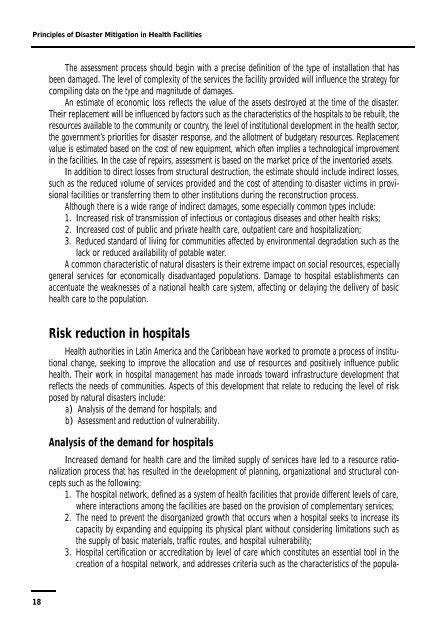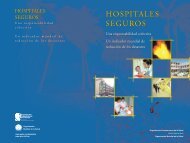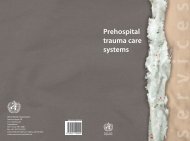Principles of Disaster Mitigation in Health Facilities - DISASTER info ...
Principles of Disaster Mitigation in Health Facilities - DISASTER info ...
Principles of Disaster Mitigation in Health Facilities - DISASTER info ...
Create successful ePaper yourself
Turn your PDF publications into a flip-book with our unique Google optimized e-Paper software.
<strong>Pr<strong>in</strong>ciples</strong> <strong>of</strong> <strong>Disaster</strong> <strong>Mitigation</strong> <strong>in</strong> <strong>Health</strong> <strong>Facilities</strong><br />
The assessment process should beg<strong>in</strong> with a precise def<strong>in</strong>ition <strong>of</strong> the type <strong>of</strong> <strong>in</strong>stallation that has<br />
been damaged. The level <strong>of</strong> complexity <strong>of</strong> the services the facility provided will <strong>in</strong>fluence the strategy for<br />
compil<strong>in</strong>g data on the type and magnitude <strong>of</strong> damages.<br />
An estimate <strong>of</strong> economic loss reflects the value <strong>of</strong> the assets destroyed at the time <strong>of</strong> the disaster.<br />
Their replacement will be <strong>in</strong>fluenced by factors such as the characteristics <strong>of</strong> the hospitals to be rebuilt, the<br />
resources available to the community or country, the level <strong>of</strong> <strong>in</strong>stitutional development <strong>in</strong> the health sector,<br />
the government’s priorities for disaster response, and the allotment <strong>of</strong> budgetary resources. Replacement<br />
value is estimated based on the cost <strong>of</strong> new equipment, which <strong>of</strong>ten implies a technological improvement<br />
<strong>in</strong> the facilities. In the case <strong>of</strong> repairs, assessment is based on the market price <strong>of</strong> the <strong>in</strong>ventoried assets.<br />
In addition to direct losses from structural destruction, the estimate should <strong>in</strong>clude <strong>in</strong>direct losses,<br />
such as the reduced volume <strong>of</strong> services provided and the cost <strong>of</strong> attend<strong>in</strong>g to disaster victims <strong>in</strong> provisional<br />
facilities or transferr<strong>in</strong>g them to other <strong>in</strong>stitutions dur<strong>in</strong>g the reconstruction process.<br />
Although there is a wide range <strong>of</strong> <strong>in</strong>direct damages, some especially common types <strong>in</strong>clude:<br />
1. Increased risk <strong>of</strong> transmission <strong>of</strong> <strong>in</strong>fectious or contagious diseases and other health risks;<br />
2. Increased cost <strong>of</strong> public and private health care, outpatient care and hospitalization;<br />
3. Reduced standard <strong>of</strong> liv<strong>in</strong>g for communities affected by environmental degradation such as the<br />
lack or reduced availability <strong>of</strong> potable water.<br />
A common characteristic <strong>of</strong> natural disasters is their extreme impact on social resources, especially<br />
general services for economically disadvantaged populations. Damage to hospital establishments can<br />
accentuate the weaknesses <strong>of</strong> a national health care system, affect<strong>in</strong>g or delay<strong>in</strong>g the delivery <strong>of</strong> basic<br />
health care to the population.<br />
Risk reduction <strong>in</strong> hospitals<br />
<strong>Health</strong> authorities <strong>in</strong> Lat<strong>in</strong> America and the Caribbean have worked to promote a process <strong>of</strong> <strong>in</strong>stitutional<br />
change, seek<strong>in</strong>g to improve the allocation and use <strong>of</strong> resources and positively <strong>in</strong>fluence public<br />
health. Their work <strong>in</strong> hospital management has made <strong>in</strong>roads toward <strong>in</strong>frastructure development that<br />
reflects the needs <strong>of</strong> communities. Aspects <strong>of</strong> this development that relate to reduc<strong>in</strong>g the level <strong>of</strong> risk<br />
posed by natural disasters <strong>in</strong>clude:<br />
a) Analysis <strong>of</strong> the demand for hospitals; and<br />
b) Assessment and reduction <strong>of</strong> vulnerability.<br />
Analysis <strong>of</strong> the demand for hospitals<br />
Increased demand for health care and the limited supply <strong>of</strong> services have led to a resource rationalization<br />
process that has resulted <strong>in</strong> the development <strong>of</strong> plann<strong>in</strong>g, organizational and structural concepts<br />
such as the follow<strong>in</strong>g:<br />
1. The hospital network, def<strong>in</strong>ed as a system <strong>of</strong> health facilities that provide different levels <strong>of</strong> care,<br />
where <strong>in</strong>teractions among the facilities are based on the provision <strong>of</strong> complementary services;<br />
2. The need to prevent the disorganized growth that occurs when a hospital seeks to <strong>in</strong>crease its<br />
capacity by expand<strong>in</strong>g and equipp<strong>in</strong>g its physical plant without consider<strong>in</strong>g limitations such as<br />
the supply <strong>of</strong> basic materials, traffic routes, and hospital vulnerability;<br />
3. Hospital certification or accreditation by level <strong>of</strong> care which constitutes an essential tool <strong>in</strong> the<br />
creation <strong>of</strong> a hospital network, and addresses criteria such as the characteristics <strong>of</strong> the popula-<br />
18

















